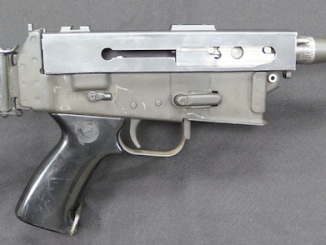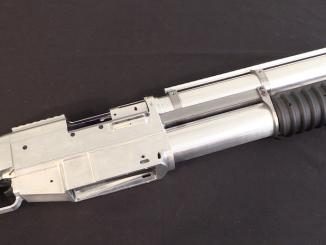A while back I had the opportunity to hit the range with Mike Carrick, Q&A Editor for Arms Heritage Magazine (a very cool magazine, by the way). The main purpose of the trip was to work with a reproduction Ferguson rifle, but Mike also brought along his hunting rifle. Well, one of them. Specifically, a 10-bore flintlock – a gorgeous copy of a 1790s British sporting rifle. So, I took the chance to ask him about it and touch off a round myself. The thing is a beast!
Related Articles

Gunsmithing
Ross Rudd’s Prototype Delayed Blowback AR180

Manual machine guns
Union Repeating Gun

Grenade Launcher

“An Earth-shattering kaboom!”
Why 12 gauge is more popular today than 10 gauge (and other bigger)?
Is there a technical reason or it was simply caused by marketing?
Daweo, The video is about large-caliber hunting rifles. As to your question (and I’m not an expert), it was my understanding that 12 gauge shotguns took over due to the perception that they were adequate tools for just about every application one would use a 10 gauge for, with less recoil and a lighter firearm. The historical exception was hunting waterfowl. I’ve read that certain technological advances in shotgun design (choke tubes and tube magazines) may have further contributed to the preference of the smaller 12 gauge shell, as one quote I saw put it: “You could do almost anything you needed to do [with a 12-gauge] by adjusting your ammo or chokes.” But we’re off topic so I will leave it at that.
Modern smokeless powders and longer chambers (3″ and 3.5″) in the 12 gauge have rendered the 10 gauge somewhat superfluous. The 12 bores tend to be lighter and more maneuverable for wing shooting, and the range of ammunition types that can be used in a 12 gauge make it much more versatile for the “one gun fits all” role. Also, waterfowl hunting regulations limit the bore size of legal hunting shotguns to 10 gauge (at least in my state). That being said, I used to duck hunt with a Beretta SxS 10 gauge, until the steel shot regulations came into effect. My current waterfowl gun is a Benelli SBE in 3.5″ 12. The Beretta still manages to find its way to the turkey blind on occasion, but as I get older, the recoil is a bit stiff. I still have a knot on my right middle finger from it getting bashed against the back of that old Beretta’s trigger guard when I was blasting away at high-flying geese and ducks in my younger days.
In the 1800’s 10 gauge shotguns were popular, in the US at least. The popularity seemed to decline starting in the smokeless era, then in 1926 the official rules of skeet did not include 10 ga. There was a brief resurgence when lead shot was banned for some hunting, but 12 gauge went to 3 1/2″ shells which made up the gap.
This is pure speculation but I’m guessing that when shotguns were doubles the incremental cost in tooling and such was not tremendous to include another gauge. With pumps and autos it was a different story and as those took over some of the lesser gauges were not worth tooling up for.
I felt sympathetic pains in my shoulder just watching the recoil.
I know, right? I used to have access to a reproduction Remington 1863 percussion rifle (the so-called “Zouave” rifle, though it doesn’t seem to have been used by actual zouaves) in .58 caliber, and that was as much of a beating as I ever wanted.
(Beautiful piece, by the way; I occasionally toy with the idea of getting one of my own, as working replicas are still made in Italy, but they’re frickin’ expensive these days.)
There is something truly beautiful with flint, steel, and black powder smoke. Big, heavy, and slow was the rule of the day when you had to “get it done with just one.” Look at some of the old muzzleloaders used for dangerous game in bore sizes of 4 or even 2 (that’s a 4 oz. to 8 oz. slug rolling out of the business end being pushed by charges suitable for light artillery). Considering the likelihood of a misfire with a flintlock, it took a lot of guts to face down a buffalo or big cat with one of those. To paraphrase Capstick, the most frightening sound in the world was not the roar of an angry lion, “but simply a click when one expects to hear a bang.”
Great video thank you fully enjoyed this gee I could almost smell the black powder thank you
“Why 12 gauge is more popular today than 10 gauge (and other bigger)?
Is there a technical reason or it was simply caused by marketing?”
because sadly knights have killed all the dragoons and there is no more t REX in the forest 🙁
Yikes! I don’t think hiding behind trees would save me from this thing!
Speaking of old-school overkill, British double rifles chambered for .450 Nitro Express were used to down a few Albatross D III’s during the Great War…
What a fantastic rifle! One of the merits of the large round balls at these sorts of velocities is that there is not much need for a projectile to expand and they shoot flat for their calibre at realistic black powder hunting ranges.
A fantastic read is The Sporting Rifle by Lieut James Forsyth of the Bengal Staff Corps published in 1867. It’s after flintlocks but he gives a very interesting description of what he considers optimal for the dangerous game of India. He is a very keen advocate of a large caliber ball coupled with a slow twist barrel (1in100″ from memory) heavily loaded to high speeds and also explores the use of shell rifles giving his own advice on the optimal explosive shell design which will explode at the right depth in a tiger.
In The Great Guns, Harold L. Peterson, writing the chapter on the American “plains rifle”, pointed out that its slow twist (1 turn in 48″) and wide, relatively shallow lands and grooves had two big advantages for that sort of use.
First, the slow-twist, shallow rifling was more durable than a finely-grooved “English” barrel with a fast twist (1 turn in 22″ was about average). It just didn’t “shoot out” as quickly, even though generally made of “softer” steel.
Secondly, it was more tolerant of varying charges and bullet wights. The finely-grooved fast-twist rifle would only be accurate with a precise charge and bullet weight (Often engraved on the barrel or the underside of the trigger-guard on English “best quality” guns).
With any other charge, it would “shoot all over the map”.
Peterson observed that in a fast-moving hunt for buffalo- or a fast-moving battle with the Blackfoot- such precision in loading would be a little difficult except with pre-prepared cartridges.
The slow twist of the plains rifle could handle widely varying charges, up to equal weights of powder and ball, with no loss of accuracy.
The big-bore, slow-twist flintlock or percussion “African” rifle had the same advantages. A light charge would knock over a bushbuck for camp meat, and you’d barely notice the recoil. A charge of nearly equal weight to the ball would bring down a bull elephant if necessary, provided you did your part with bullet placement.
And yes, reproduction plains rifles in .50 to .54 caliber have been taken to Africa, and have taken all of the Big Five. Not surprising, as ballistically they are very close to the .450 and .500 category of blackpowder Express metallic cartridges.
cheers
eon
James Forsyth found his best rifling set up had very broad grooves with narrow lands. Apparently this was easier to load fast and cleaner. He commented that English guns were very prone to stripping the bore if loaded heavily enough for hunting. He was keen on 14bore as a starting point for game like sambar deer tigers.
With these big rifles, for me it’s good to let myself roll back and the gun go up. Follow the recoil and guide it, rather than try to beat the physics.
Because there are lots of physics.